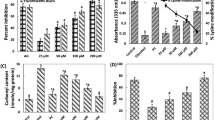Summary
The amino-carbonyl reaction (The Maillard reaction) of bovine lens crystallin, serum albumin or skin collagen with glucose was investigated to find effective means to prevent the formation of Advanced Glycation End Products (AGE) and induce the reversible solubilization of polymerized glycated proteins. The organic germanium compounds (Ge-132, 373, 385), derivatives of amino acids containing germanium as the linker of framework, were combined by the box titration method to determine the dose that would be most effective, compared with Aminoguanidine-HCl (AMG),α-tocopherol (VE), and pirenoxine (Catalin-K, CK). Although AMG suppressed the formation of AGE, effective concentrations were higher than 20 mM. Ge-385, when administered by itself at a low dose, induced the reversible solubilization of AGE made from crystallin, and albumin. The addition of any two reagents such as AMG, VE, CK and Ge-132 or 385 together to proteins lessened the effective range, and the peaks of smaller molecules in the profiles of HPLC and PAGE were quite remarkable. Examination was made of the effects of Ge-132 on the eyes of SAM mice, which show senescence accelerated cataracts at a relatively young age. The prevention of cataract-genesis and induction of reversible transparency of turbid lenses became evident following the administration of Ge-132 to the eyes 4 times a day. The mode of action of organic germanium compounds was demonstrated quite capable of disconnecting the sugar-parts from AGE by decarbonylation, resulting in the formation of glucosone and amino residues, and further leading subsequently to fewer AGE.
Similar content being viewed by others
References
Brownlee M, Vlassara H, Koony A, Ulrich P, Cerami A (1986) Aminoguanidine prevents diabetes-induced arterial wall protein cross-linking. Science 232: 1629–1632
Brownlee M, Cerami A, Blassara H (1988) Advanced glycosylation end products in tissue and the biochemical basis of diabetic complications. N Engl J Med 318(20): 1315–1321
Hosokawa M, Ashida Y, Tsuboyama T, Chen WH, Takeda T (1988) Cataract in Senescence accelerated mouse (SAM) (II). Development of a new strain of mouse with lateappearing cataract. Exp Eye Res 47: 629–640
Kawakishi S, Okawa Y, Uchida K (1990) Oxidative damage of protein induced by the amadori compound-copper ion system. J Agricult Food Chem 38: 13–17
Miyao K, Tanaka N (1988) Carboxyethylgermanium sesquioxide and related organogermanium compounds. Unique synthetic BRM's. Drugs Future 13(5): 441–453
Monnier VM, Kohn RR, Cerami A (1984) Accelerated age-related browning of human collagen in diabetes mellitus. Proc Nat Acad Sci USA 81(2): 583–587
Ogino S (1955) Study on the therapy of cataract. 2. Prevention of quinoid-cataract by Catalin and its mode of action. Clin Ophthalmol 11: 272–278 (in Japanese)
Poehling HM, Neufoff V (1981) Visualization of proteins with a silver “stain”: A critical analysis. Electrophoresis 2: 141–146
Takeda T, Hosokawa M, Takeshita S, Irino M, Higuchi K, Matsushita T, Tomita Y, Yasuhira K, Hamamoto H, Shimizu K, Ishii M, Yamamuro (1981) A new murine model of accelerated senescence. Mech Aging Dev 17: 183–194
Author information
Authors and Affiliations
Additional information
Abbreviations used in this paper: BLC bovine lens crystallin; BSA bovine serum albumin; AsCol acid soluble bovine skin collagen type III; AGE advanced glycation end products; Ge-132 2-Carboxyethylgermanium sesquioxide, Ge-373 2-Carboxy-2-amino-6-phenyl germanium sesquioxide; Ge-385 2-Carboxy-ethyl-2-aminogermanium sesquioxide; AMG or AG aminoguanidine-HCl; V. E. vitamin E orα-tocopherol; CK 1-Hydroxy-5-oxo-5H-pyrido [3, 2-a] phenoxazine-3-carboxylic acid or catalin-K or pirenoxine; PACE polyacrylamide gel electrophoresis; SAM senescence accelerated mouse; HPLC high pressure liquid chromatography; SDS sodium laurylsulfate; FT fructose-p-toluidine.
Rights and permissions
About this article
Cite this article
Nakamura, K., Nomoto, K., Kariya, K. et al. Prevention and reversible solubilization of advanced glycation and products (AGE) by organic germanium compounds as derivatives of amino acids. Amino Acids 1, 263–278 (1991). https://doi.org/10.1007/BF00806925
Issue Date:
DOI: https://doi.org/10.1007/BF00806925




